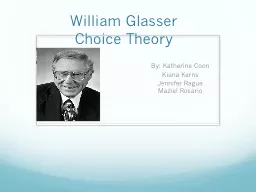

Choice Theory By Katherine Coon Kiana Kerns Jennifer Rague Maziel Rosario Introduction Control Theory Sounded more positive Anticipatory Set We are always trying to choose behavior in a way that best satisfies our needs Glasser ID: 302917
Download Presentation The PPT/PDF document "William Glasser" is the property of its rightful owner. Permission is granted to download and print the materials on this web site for personal, non-commercial use only, and to display it on your personal computer provided you do not modify the materials and that you retain all copyright notices contained in the materials. By downloading content from our website, you accept the terms of this agreement.
Slide1
William GlasserChoice Theory
By: Katherine CoonKiana Kerns Jennifer Rague Maziel RosarioSlide2
Introduction
Control Theory Sounded more positive Slide3
Anticipatory Set
“We are always trying to choose behavior in a way that best satisfies our needs”- GlasserSlide4
Anticipatory Activity What are your five basic needs?
1.________________________2.________________________3.________________________4.________________________5.________________________How they compare to Glasser’s theorySlide5
Glasser’s Background
Born 1925 Case Western Reserve University Has degree in psychiatry Psychiatric training at the Veterans Administration HospitalSlide6
Fundamental Principles
Satisfying 5 basic needsStudent and teacher share powerSelf motivated students Slide7
The Quality WorldSmall, personal, specific
Core of every person’s lifeBest satisfies our needspeople, things, beliefsTeachers roleImportant part or shut outSlide8
Four Psychological Needs
1. The need to belongOne of the most powerful human needsFeeling significantSlide9
Four Psychological Needs
2. The need for powerThe most difficult to fulfillFrustrating for studentsTeachers as a guideCooperative LearningSlide10
Four Psychological Needs
3. The need for freedomTheir choices and ideas are importantAble to have and utilize them4. The need for funFind pleasure in the activity Slide11
Physical NeedSurvival – physically and emotionally safe
Allow snacks, water breaks, growing plants, opening windowsMaintain behavior guidelinessafety and respectConsistent procedures and routinesOrder and securitySlide12
Teachers as a Leadercaring
ListeningEncouragingLaughingNo coercionReward or punishmentNot effective or respectful Slide13
Teacher as a LeaderFour characteristics
EngagingModelingAskingPerformingSlide14
Classroom MeetingsEntire class involved
Discusses concerns/issues, works towards resolutionsOpen, accepting, trusting environmentBriefNo more than 30 minutesSlide15
Types of Classroom Meetings
Social problem solvingEducational-diagnosticOpen-endedSlide16
Strengths
Students learn independenceStudents make the rules Students take responsibility for their behavior/selfSlide17
Strengths
Satisfies the 5 basic needsStudents establish self esteem/self worth Slide18
Strengths
The skills can be used throughout lifeNo rewards or punishment Cooperative learning satisfies the need for power Slide19
Disadvantages
Needs administrative approvalHard when changing classes all day Excessive training and timeSlide20
Disadvantages
Exceptional learnerStudents can’t manage their own behaviorNo rewards or punishmentResistant students Students may dislike you Slide21
Disadvantages
Teachers care too muchNot immediate Slide22
Student Expectations
They are responsible for themselves They must be self motivatedThey make the choice to pass or failSlide23
Student Expectations
Make rules with teacher Describe present behavior Slide24
Student Expectations
Find a solution to what isn’t working Identify consequence Slide25
Important Points To Remember
Non-threatening environment (Survival)Guided Self-Assessments (Belonging)Think of Choices (Fun & Freedom)Make a Plan (Sharing Power)RemovalSlide26
When To Use This Theory
As a group we decided that this theory is best used……To keep an equal balance of powerTo help “in control” student make good choicesLearn to have responsibility To keep us teachers in the quality worldSlide27
Case Study (Class)
Miss Jamie’s kindergarten class is outside playing having a great time when she notices one of her students is misbehaving. He seems to be hitting one of his classmates and thinking it’s fun. Using choice theory as a class lets write out the actions that should take in place.Slide28
Conclusion
"Life is hard enough without the continuing harangues of the doomsayers. In a world that uses choice theory, people would be more optimistic." William GlasserSlide29
Graphic Citations For Jennifer Rague
Slide 1: http://pegasus.cc.ucf.edu/~csrce/pages/summer2002.htmlSlides 2,3,5 : www.office.microsoft.comSlide30
Graphic Citations for Kiana Kerns
Slide 7: www.freeclipartnow.comSlides 8, 14, 15: www.office.microsoft.comSlides 9, 10, 11: www.hasslefreeclipart.comSlides 12, 13: www.school-clip-art.comSlide31
References For Jennifer Rague
Glasser, w. (2010). The William Glasser Institute. Choice theory. Slide32
References for Kiana Kerns
Glasser, W. (1997). "Choice theory" and student success.The Education Digest, 63, 16-21. Retrieved February 15, 2011, from the Education; Readers' Guide (Current Events) database. Powell, R. R. (2001).Classroom management: perspectives on the social curriculum
. Upper Saddle River, N.J.: Merrill/Prentice-Hall
.
Glasser
, W. (1997). A new look at school failure and school success.
Phi Delta
Kappan
,
78
, 596-602.